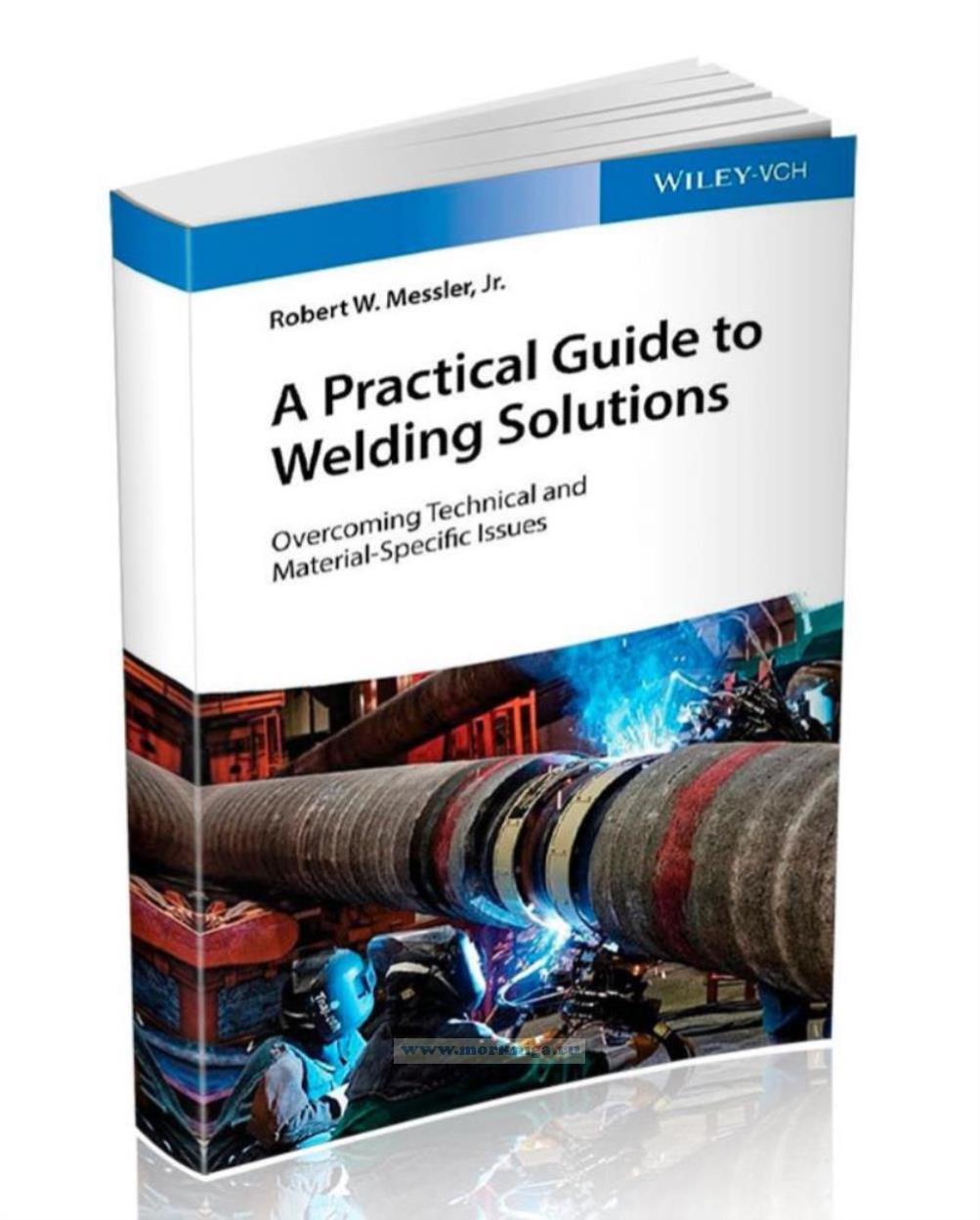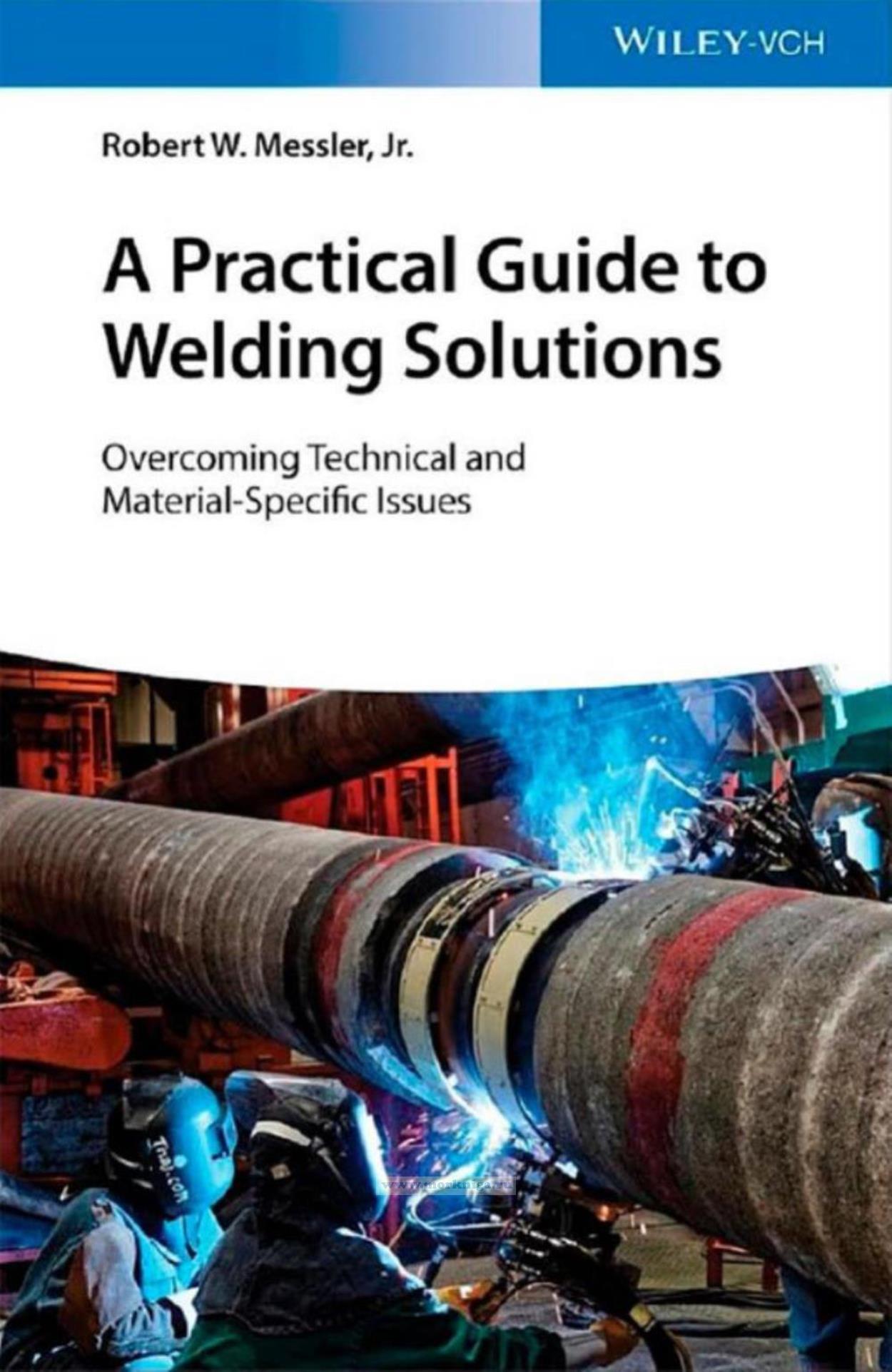A Practical Guide to Welding Solutions/Практическое руководство по решению проблем сварочного производства
Книга на английском языке.
As critically important as welding is to a wide spectrum of manufacturing, construction, and repair, it is not without its problems. Those dependent on welding know only too well how easy it is to find information on the host of available processes and on the essential metallurgy that can enable success, but how frustratingly difficult it can be to find guidance on solving problems that sooner or later arise with welding, welds, or weldments. Here for the first time is the book those that practice and/or depend upon welding have needed and awaited. A Practical Guide to Welding Solutions addresses the numerous technical and material-specific issues that can interfere with success. Renowned industrial and academic welding expert and prolific author and speaker Robert W. Messler, Jr. guides readers to the solutions they seek with a well-organized search based on how a problem manifests itself (i.e., as distortion, defect, or appearance), where it appears (i.e., in the fusion zone heat-affected zone, or base metal), or it certain materials or situations.
Contents
Preface
1 Introduction
Further Reading
2 Categorization of Welding and Weld Problems
2.1 What Is Welding?
2.2 Microstructural Zones of Welds
2.3 Origin of Problems in Welding and Welds
2.4 How Problems Can Be Logically Categorized?
References
Further Reading
Part I Manifestation of Problems with Welds and Weldments
3 Problems with Joint Setup and Weld Joints
3.1 Joint Efficiency
3.2 Weld Joint Types and Weld Configurations
3.3 Joint Setup Problems
3.4 Problems with Weld Profile
3.5 Troubleshooting Guide
References
Further Reading
4 Shape Distortion, Dimensional Shrinkage, and Geometric Instability
4.1 Thermal Versus Mechanical Stresses in a Structure
4.2 Residual Stresses Versus Distortion
4.3 Origin and Effect of Volumetric Shrinkage
4.4 Origin and Effect of Thermal Contraction
4.5 Problems from Nonuniform Thermal Contraction and CTE Mismatches
4.6 Problems from Distortion and from Residual Stresses
4.7 Distortion Control and Residual Stress Reduction
4.8 Troubleshooting Guide
References
Further Reading
5 Porosity
5.1 The Most Common Problemin Welds
5.2 Types of Weld Porosity
5.3 Gases in Molten Weld Metal
5.4 The Many Possible Causes of Porosity in Welds
5.5 Attempting to Minimize Porosity Formation in Fusion Welds
5.6 Troubleshooting Porosity Problems in Welds
References
Further Reading
6 Cracks
6.1 The Most Dreaded Defect in Welds
6.2 Classification of Cracking and Cracks in Welds and Welding
6.3 Hot Cracking and Cracks
6.4 Cold Cracking and Cracks
6.5 Other Weld-Related Cracking and Cracks
6.6 Crack-Prone Metals and Alloys
6.7 Troubleshooting Cracking Problems in Welds
References
Further Reading
7 Nonmetallic and Metallic Inclusions
7.1 Solid Versus Gas Inclusions
7.2 Nonmetallic Inclusions in Welds
7.3 Metallic Inclusions in Welds
7.4 Troubleshooting Problems with Inclusions in Welds
References
Further Reading
8 Weld Appearance
8.1 Can You Judge a Book by Its Cover? Is Beauty Only Skin Deep?
8.2 Weld Crown Bead Faults
8.3 Weld Root Bead Faults
8.4 Fillet Weld Faults
8.5 Reading Weld Ripple Marks
8.6 Weld Spatter
8.7 Arc Strikes
8.8 Weld Heat Tint
8.9 Troubleshooting Weld Appearance Problems
References
Further Reading
9 Fusion Zone of Fusion Welds
9.1 A Refresher on Microstructural Zones in and Around Welds
9.2 Gas Porosity in the Fusion Zone of Welds
9.3 Cracking in the Fusion Zone of Welds
9.4 Inclusions in the Fusion Zone of Welds
9.5 Macrosegregation in the Fusion Zone of Welds
9.6 Troubleshooting Problems in the Fusion Zone of Welds
References
Further Reading
10 Partially Melted Zone of Fusion Welds
10.1 Origin and Location of the PMZ in Fusion Welds
10.2 Conventional Hot Cracking in the PMZ
10.3 Constitutional Liquation Cracking in the PMZ
10.4 Cold Cracking in the PMZ
10.5 Overcoming Cracking Problems in the PMZ
10.6 Troubleshooting Problems in the PMZ
References
Further Reading
11 Heat-Affected Zone of Fusion Welds
11.1 Origin and Location of the HAZ for Fusion Welds
11.2 Manifestation of Problems in the HAZ of Fusion Welds
11.3 Precipitation-Hardening Alloy HAZ Problems
11.4 Sensitization in the HAZ of Austenitic Stainless Steels
11.5 Transformation-Hardening Steel HAZ Problems
11.6 Reheat Cracking
11.7 Troubleshooting Problems in the HAZ of Fusion Welds
References
Further Reading
12 Unaffected Base Metal Cracking Associated with Welding
12.1 Weld-Related Problems in the Unaffected Base Metal
12.2 Lamellar Tearing in Thick Steel Weldments
12.3 Corrosion Cracking Caused by Fusion Welding
12.4 Fatigue Cracking Outside Fusion Welds
12.5 Troubleshooting Weld-Related Problems in the Unaffected Base Metal
References
Further Reading
13 Discontinuities in Multi-pass Welds
13.1 Needs for Multi-pass Welding and Welds
13.2 Various Functions of Multi-pass Welding and Welds
13.3 Defects Found in Multi-pass Welds
13.4 Composition Adjustment with Multi-pass Welding
13.5 Property Alteration with Multi-pass Welding
13.6 Troubleshooting Problems in Multi-pass Welding and Welds
References
Further Reading
14 Problems with Non-fusion Welding and Non-fusion Welds
14.1 Non-fusion Welding Processes Versus Fusion Welding Processes
14.2 Overview of Non-fusion Processes
14.2.1 Pressure Welding Processes
14.2.2 Friction Welding Processes
14.2.3 Diffusion Welding Processes
14.2.4 Solid-State Deposition Welding
14.3 Problems with Non-fusion Welds and Non-fusion Welding Processes
14.4 Inspection and Repair Challenges with Non-fusion Welds
14.5 Troubleshooting Problems with Non-fusion Welds
References
Further Reading
Part III Material-Specific Weld-Related Problems
15 Embrittlement of Carbon and Low- and Medium-alloy Steels
15.1 The Importance of Steel
15.2 Four Causes of Embrittlement in Carbon and Low- and Medium-alloy Steels
15.3 Hydrogen Embrittlement: A Misnomer in Steels
15.4 Secondary Hardening in Steels
15.5 Ductile-to-Brittle Transition in Steels
15.6 Compromise of Fatigue and Impact Behavior by Residual Stresses in Steels
15.7 Troubleshooting Problems from Embrittlement of Steels by Welding
References
Further Reading
16 Sensitization or Weld Decay and Knife-line Attack in Stainless Steels
16.1 A Primer on the Metallurgy of Stainless Steels
16.2 Sensitization of Austenitic Stainless Steels by Welding
16.3 Sensitization of Other Grades of Stainless Steel
16.4 Knife-line Attack in Stabilized Austenitic Stainless Steels
16.5 Troubleshooting Problems from Sensitization or Knife-line Attack
References
Further Reading
17 Stress Relief Cracking of Precipitation-Hardening Alloys
17.1 Different Names, Same Phenomenon
17.2 Stress Relief Cracking in Ferritic Alloy Steels
17.3 Stress Relaxation Cracking in Stainless Steels
17.4 Strain-age Cracking in Ni-Based Superalloys
17.5 Troubleshooting Problems from Stress Relief or Strain-age Cracking
References
Further Reading
18 Loss of Properties in Cold-Worked Metals and Alloys
18.1 Cold-Work, Recovery, Recrystallization, and Grain Growth
18.2 Cold-Worked Metals and Alloys in Engineering
18.3 Avoiding or Recovering Properties Loss from Fusion Welding
18.4 The Worked Zone in Pressure-Welded Metals and Alloys
18.5 Troubleshooting Welding Problems in Cold-Worked Metals and Alloys
References
Further Reading
19 Embrittlement with High-chromium Contents
19.1 Phase Formation and Structure
19.2 Adverse Effects of ?-Phase
19.3 Susceptible Alloys
19.4 Guidelines for Avoiding or Resolving Problems from ?-Phase
19.5 Troubleshooting Problems with ?-Phase Associated with
Welding
References
Further Reading
20 Weld Dilution and Chemical Inhomogeneity
20.1 The Designer’s Druthers
20.2 Chemical Inhomogeneity in Welds
20.3 Weld Dilution
20.4 The Unmixed Zone in the Weld Metal
20.5 Impurities in the Weld Metal
20.6 Troubleshooting Problems from Weld Dilution and Chemical
Inhomogeneity
References
Further Reading
21 Dissimilar Metal and Alloy Welding
21.1 Joining Dissimilar Materials
21.2 The Need for Welding Dissimilar Metals and Alloys
21.3 Chemical Incompatibility
21.4 Mechanical Incompatibility
21.5 Thermal Incompatibility
21.6 Troubleshooting Problems with Dissimilar Metal and Alloy
Welding
References
Further Reading
Closing Thoughts
Index

